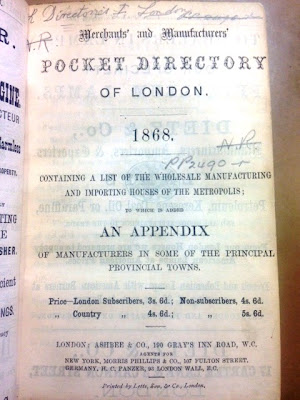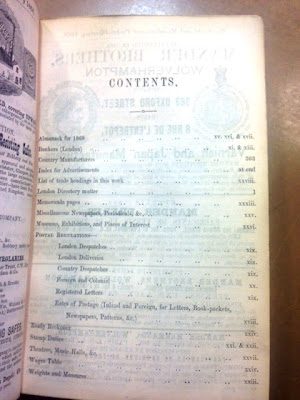In the final part of this series about William Ashbee, I
want to round off the story of his historic copyright case with some contextual
details, including the location of his offices, the directory itself, some
court transcripts, and his youngest son (also William).
The Merchants'
and Manufacturers' Pocket Directory of London is a rare publication by
virtue of the associated copyright case. In fact, I doubted whether any copies
might have survived. WorldCat.org lists just one microfilm copy in the Duke
University Libraries, North Carolina. However, that entry also includes a
credit to the British Library Reference Division, Reprographic Section. I
therefore approached their Rare Books and Music Reference Service and they
confirmed that they do actually have a physical edition.[1]
Although I have requested a full copy, they kindly provided me with the
following images of the leading pages, free of charge, in order to display
here.
Figure 1 - Merchants'
and Manufacturers' Pocket Directory of London, preface; © The British
Library Board, P.P.2490.R; Displayed by permission of the British Library.
Figure 2 - Merchants'
and Manufacturers' Pocket Directory of London, title page; © The British
Library Board, P.P.2490.R; Displayed by permission of the British Library.
Figure 3 - Merchants'
and Manufacturers' Pocket Directory of London, contents; © The British
Library Board, P.P.2490.R; Displayed by permission of the British Library.
The preface was written in December 1867, although the
publication occurred some time during 1868. The title page shows that Ashbee
& Co. were also agents for publishers in New York and in Germany; clearly
they were looking to become as successful as the many other publishers of
directories from that period.
The directory’s title page also shows that their first office
was 190 Gray’s Inn Road, London, and that tallies with the information
presented in Part
I of this series. Google Maps shows that this address still exists,
although it was a café at the time of writing.
Figure 4 - Gray's Inn Road, London. Google street view,
April 2015.
At some point after this edition was printed, they moved
their offices to 32 Bouverie Street, off Fleet Street, and that is where they
were when the bill was filed. I searched in vein to find an image of that
street from the 19th Century. Much of it has been redeveloped but it
was host to several publishers and printers at the time, including the offices
of the Daily
News newspaper, established 21 Jan 1846, and famous for its steadfast
coverage of the American Civil War when no others saw the global significance
of it. The first editor of that newspaper was no less than Charles Dickens,
although his position only lasted about three weeks.[2]
In order to locate where number 32 was, I consulted a directory
from 1882, and the following is a transcript of that street, running south from
Fleet Street, down the west side to Tudor Street, and then back up the east
side.[3]
Bouverie st. 62 Fleet st.
(E.C.) (CITY) MAP M9.
...
here is Pleydell street...
1
& 2 Mackey, Mackey & Co. wholesale druggists
3
Haddon John & Co. publishers
Smith Henry, die sinker
Bennett John, bkbndrs.’ tool
cuttr
4
Appleton Alfred J. wood engraver
Crane Hy. Jas. wood
engraver
Hughes Henry, printer
MacGeorge Edward & Co. advertising
agents
6
Swain Joseph, wood engraver
Evison & Bridge, law
stationers
7
Paterson, Sons & Garner, solictrs
8
to 10 Bradbury, Agnew & Co. prntrs
...
here is Essex Street ...
11
International News Co. exporters
12
Watson, Sons & Room, solicitors
13
Butcher Webster, solicitor
Hipsley John Hy.
draughtsman
Skelton Robert,
engraver
14
Spackman Leonard, job master
15
Gale & Co. wholesale druggists
OTHER
SIDE
16
Burnell H. Hockey, F.S.A. archtct
17
Davies Charles Edward, printer
17½
Clayton & Co. printers
18
Miall Charles Septimus
Gadsby John, publisher
...
here is George Yard ...
19,
20 & 21 Daily News Newspaper Office
22
Hall Thomas & Co. silversmiths
Everett Wm. Hy. advertising
agt
23
Symmons & Sons, bookbinders
Irons Clarke & Co. wood
engravrs
Atkins Alfd. H. companies'
statnr
Garmeson Miss Mary Ann, ladies'
school
24
Wells Chs. T. engravers’ block ma
Country Brewers' Gazette Office
Dyer (The) Office
Oil
& Drug Journal Office
25
Hawksworth, Eyre & Co. Limited, silversmiths
Delitsch Paul, die
sinker
Long Henry, draughtsman
Phipps George B.
stationer
Pool Charles, advertising
agent
26
Dupere John Wm. cigar merchnt
27,
28 & 29 Martin, Hall & Co. Limited, silversmiths,
James Crossley, agent
Crossley Jas. manufctrs.'
agent
30
Sussex, Mrs. Mary Ann Jones
31
Dunn & CO. printing ink manfrs
32
Murby Thomas, publisher
33
Dane J. & Co. printing ink makrs
34
Williamson Peter William, engravers’ block maker
Wileman William
publisher
Number 32 was still host to Thomas Murby, the previous
publisher that I identified in Part I, and so the premises must have been
shared with him. Interestingly, number 30 was the official address of the huge The News of the World
offices until the newspaper's closure in 2011, and must have engulfed anything
remaining of number 32. The following maps help to put the directory details in
perspective: London,
1:1056, 1893-1895 and London/TQ,
1:1250/1:2500, 1947-1964, but they do not identify no. 32 specifically. I
can infer that it was across the road from Pleydell Street, and slightly lower
down, but no more.
Whilst writing this up, I found the most incredible map
of the street from 1886 that showed the exact building, and even some of the
internal detail. This was part of a series of fire insurance maps produced by Charles E. Goal Ltd., and it confirmed
that my estimate was spot-on.[4]
While researching for this series of articles, I obtained
copies of a number of documents from a file held by The National Archives of
the UK (TNA).[5] These included affidavits and
depositions by the plaintiff
and others, and interrogatories for the case itself.
Earlier affidavits from both the defendant and the plaintiff
were held in chancery files held offsite from TNA’s Kew location. These took
longer to obtain and so weren’t in the first edition of this article.
These have all been
transcribed and attached to this blog for future use.
Affidavit from William Ashbee, 6 May 1868, before George
White.
.
Affidavit from John Stuart Crosbie Morris, 20 May 1868,
before Benham and Tindell.
Deposition taken in the cause from John S. C. Morris and
John A. Keith. Also, an affidavit from James Hutchings.
.
Later affidavit from John S. C. Morris.
Interrogatories for the case of Morris v. Ashbee.
William’s youngest son, also William, was born 29 Nov 1836
in the parish of Westonbirt. The evidence for this comes from a Civil Service
evidence-of-age record that contained a sworn statement by his father, made at
Tetbury on 5 Apr 1861:[6]
“ 'I' William Ashbee of Tetbury
in the County of Gloucester Baker 'do solemnly and sincerely declare that' I
have looked at the paper writing hereunto annexed and marked with the letter
"A" purporting to be an Extract from the Register Book of Baptisms in
the parish of Westonbirt in the County of Gloucester and that William, the son
of William and Anne "Ashby" therein referred to, is the same person
as William Ashbee my Son who was born on the twenty ninth day of November one
thousand eight hundred and thirty six, his Birth was never registered but
<from> an entry made by my wife in a family Bible belonging to me, and
<which I now> produced at the time of my ^making this Declaration^ <Birth>
enabled me to speak confidently to the fact ”
William junior similarly began as a baker and grocer, and in
the 1861 census both he and his father were sharing that work on Long Street,
Tetbury.[7]
However, on 7 May 1863, he was appointed as a ‘Lr. Cr’ [Letter Carrier] with
the British Post Office in London.[8] In
view of the declaration made by the father, above, and the future location of
the family in London, I believe that they moved from Tetbury shortly after
1861. In c1866, he married May A[nn] Hale in Holborn, Middlesex.[9]
In the 1871 census, his occupation appears to be ‘Travellor’,
residing at 9 Churton Street, St. John, Middlesex, although it’s hard to be
100% certain of the letters.[10]
It does make sense, though, if we move on to 6 July 1878 when his young
daughter, Annie Mary Henrietta, died of ‘Intussusception
7 days’ [telescoping of intestinal segment], aged 9, in Matlock Bath,
Derbyshire, about 150 miles N-NW of that residence.[11]
William’s occupation was given as ‘Publishers Agent’. Also, in the 1881 census,
his wife was head of the household at 151 Church Rd, Islington, London,[12]
but William was lodging with the family of a commercial traveller named Edward
M. Jones at 61 Grant St, Birmingham.[13]
Clearly William travelled a lot while working for a publishing firm.
William had been involved in a
court case himself in July 1873, shortly after his father’s death. In that case
(Ashbee v. Ingoldby), William was the
plaintiff and claimed that on the 6 Aug 1869 his father had agreed with the
defendants for the publication of a work in French, English, and German, to be
called "The International Guide to the British, Foreign, and Colonial
Manufacturers, Exports, and Shippers". The agreement allegedly noted that
his father “was possessed of the requisite knowledge, information, and plant
and effects for the production of such a work”, and so was entitled to the
copyright. The defendants went to America in August 1869 but returned in November
of the same year due to an unsuccessful outcome of the enterprise. In the mealtime,
William's father had employed him to manage the business in England, which had
been successful. Soon after the death of his father, he received a notice from
Ingoldby that they (William Ashbee &
Co., but in the name of Ingoldby
& Co.) had employed another manager in his place, and substituted a Mr.
Lamb for a Mr. Rest, who had retired, both without the permission of William or
of a Mr. Hales (another partner). Also, having sold a first edition of the
work, they were preparing to release a second. William filed for an injunction
on this, and claimed, as administrator of his late father's affairs, that he
was entitled to a considerable portion of the profits, and other relief. The
defence argued that the agreement was vague and there was no explicit mention
of copyright, and also that the plaintiff had delayed too long before coming to
court. The Vice-Chancellor (Sir.
John Wickens) sided with the defence and dismissed the motion, but without
costs.[14]
So, had the bankrupt Ashbee & Co. been replaced by a
“successful” William Ashbee & Co. before
the coup d'état? The “Mr. Lamb”
sounded like one of the defendants in the
Morris v. Ashbee case described in Part II. A quick search revealed that he
was that same Alexander Lamb, and in 1876 he was then a member of the publishing
firm of Ingoldby & Lamb, of 3
Whitefriars Street, London.[15]
William’s wife, Mary Anne, died in
c1890 in Islington aged 47,[16]
and the Electoral Registers for 1889 & 1890 confirm their address as 24
King Edward’s Street, Islington.[17]
NB: Women did not have the vote at that time and so her absence from the
register is not evidence of her death. In 1901, he’d moved to Nottingham and
was living in the household of his widowed sister, Emma J. Stanton, at 37
Lavender Street.[18]
William’s occupation was then given as ‘Pensioner Civil Service’. In 1901, he
was still living with his widowed sister but at 42 Norland Road: the household
of her son-in-law.[19]
No occupation was given.
William died at some point after
this but it wasn’t obvious where; it wasn’t in London, Tetbury, or Nottingham.
The clue finally came in the form of a minor court case in Yorkshire. He was
charged with obtaining £3.3.0 by false pretences, and committed on 9 Oct 1895
at Halifax. He was later acquitted at HMP Wakefield Prison Sessions on14 Oct
1895.[20]
The notes describe him as: a ‘Baker’, 5' 7 ¾" tall, grey hair, and with an
abscess scar under his left arm. I therefore looked for his death in the county
of Yorkshire.
The spelling of his surname is
considerably less common than the “Ashby” form. However, fate was determined to
make me pay twice as much as I wanted to for a death certificate — probably as
punishment for my lack of humour in Parts I & II. You see, there were two
William Ashbees, both died in Yorkshire, in the same year (1907), and at the
same age (70). Honestly, you couldn’t make this stuff up. The correct one of
these recorded that he died 24 Jan 1907 at 48 Cannon Street, Glasshoughton, W.
Yorkshire, aged 70, of ‘cerebral haemorrhage’.[21]
The informant was J. R. Ashbee [son] of 151 Barnsbury Rd, London, who was in
attendance., and William’s occupation was recorded as ‘Commercial Clerk’. The
other death certificate was for a silversmith in Ecclesall Bierlow.
Note that the eldest son of this
William was the William Henry Ashbee mentioned in some detail in the previous
articles: A
Life Revealed and More
of a Life Revealed, thus connecting the details of this family up to the current
generations.
It seems that the Ashbee family
did not succeed in publishing to the extent of some other firms; they were hit
by too many tragedies and misfortunes. But supposing they had succeeded — what
would the effect have been on the family, the publishing world, the legal
world, and even the digital age?
** Updated 31 March 2016 to include missing affidavits from
William Ashbee **
[1] Merchants' and
Manufacturers' Pocket Directory of London
(London: Ashbee & Co., 1868); British
Library, Shelfmark: General Reference Collection P.P.2490.R.
[3] Post Office London
Directory, 1882. [Part 1: Official & Street Directories], pp. 195-6
(image 218-9 of 783), online PDF, University of Leicester, compiler, Historical
Directories (http://specialcollections.le.ac.uk/cdm/compoundobject/collection/p16445coll4/id/8865/rec/1
: accessed 29 Aug 2015),
[4] Insurance Plan of City of
London, vol. II: sheet 31 (Charles E. Goad Ltd., 1886), scale 1:480;
"Online Gallery", British
Library (http://www.bl.uk/onlinegallery/onlineex/firemaps/england/london/itov/zoomify150175.html<
/a> :
accessed 14 Sep 2015), shelfmark: Maps 145.b.22.(.2).
[5] “Morris v.
Ashbee”, 1868, cause number: 1868
M81; The
National Archives of the UK (TNA), ref: C 16/514/M81 (http://discovery.nationalarchives.gov.uk/details/r/C7896228
: accessed 17 Sep 2015); interrogatories (41 A3 MS
pages), depositions by John S. C. Morris and John A Keith plus affidavit by
James Hutchings (7 A3 TS and 16 A3 MS pages, MS copy of Hutching's affidavit
missing, MS/TS copies of Ashbee's affidavit both missing), affidavit by John S. C.
Morris (2 A3 TS pages).
[6] "Civil service evidence of age", database with images, Findmypast (www.findmypast.co.uk :
accessed 16 Sep 2015), entry for
William Ashbee born 1836; Surviving records deposited
at the Society of Genealogists (SoG) by the Civil Service Commission (CSC).
[7] "1861 England Census", database with
images, Ancestry (www.ancestry.co.uk :
accessed 24 Aug 2015), household of William
Ashbee (age 58); citing
RG 9/1780, folio 44, page
36; TNA.
[8] "British Postal Service Appointment Books, 1737-1969",
database with images, Ancestry
(www.ancestry.co.uk : accessed 16 Sep 2015), entry for W. Ashbee, appointed 7 May
1863, no. 691; citing Post Office: Staff nomination and appointment, 1831-1969.
Microfilm, POST 58, 80 rolls; British Postal Museum and Archive. London, England.
[9] Transcribed GRO Index for England and Wales (1837–1983), database,
FreeBMD (http://freebmd.rootsweb.com/cgi/seach.pl
: accessed 15 Sep 2015), marriage
entry for William
Ashbee and Mary A. Hale; citing Holborn, 1866, Mar [Q1], vol.1b:671.
[10] "1871 England Census", database with
images, Ancestry (www.ancestry.co.uk :
accessed 16 Sep 2015), household of William
Ashbee (age 34); citing
RG 10/123, folio 104, page
26; TNA.
[11] England, death certificate for Annie
Mary H. Ashbee, died 6 July 1878; citing 7b/413/8, registered Bakewell 1878/Sep
[Q3]; General Register Office (GRO), Southport.
[12] "1881 England Census", database with images, Ancestry (www.ancestry.co.uk : accessed
16 Sep 2015), household of Mary A. Ashbee (age 38); citing RG 11/250, folio 119, page 59; TNA.
[13] "1881 England Census", database with images, Ancestry (www.ancestry.co.uk : accessed
16 Sep 2015), household of Edward M. Jones (age 33); citing RG 11/2974, folio 52, page 39; TNA.
[14] "Equity Courts - Saturday: Ashbee v. Ingoldby", Morning Post (28 Jul 1873): p.7. “WICKENS V.C.: 25–26 July 1873: ASHBEE v.
INGOLDBY”, The Law Journal: Notes of
Cases Decided in All The Superior Courts of Law and Equities, Vol.
VIII–1873, Hilary Term 1873 to Hilary Term 1874 (London: E. B. Ince, Chancery
Lane, 1873), p.147.
[15] "The Proceedings of the OLD BAILEY: London's Central Criminal
Court, 1674 to 1913", Old Bailey
Proceedings Online, version 7.2 (http://www.oldbaileyonline.org/browse.jsp?div=t18760918-426
: accessed 16 Sep 2015), entry for September 1876, trial of GEORGE GODFREY
HARMAN (66) (t18760918-426).
[16] Transcribed GRO Index for England and Wales (1837–1983), database,
FreeBMD (http://freebmd.rootsweb.com/cgi/seach.pl
: accessed 15 Sep 2015), death
entry for Mary Anne
Ashbee; citing Islington, 1890, Mar [Q1], vol.1b:256.
[17] "London, England, Electoral Registers, 1832-1965",
digital images, Ancestry
(www.ancestry.com : accessed 16 Jul 2014), entries for William Ashbee in years 1889 & 1890,
Islington borough, St Mary’s polling distinct, p.62 & p.63 (respectively); citing Electoral
Registers, London Metropolitan Archives.
[18] "1891 England Census", database with images, Ancestry (www.ancestry.co.uk : accessed
16 Sep 2015), household of Emma J. Stanton (age 57); citing RG 12/2694, folio 134, page 39; TNA.
[19] "1901 England Census", database with images, Ancestry (www.ancestry.co.uk : accessed
16 Sep 2015), household of Joseph Brooks (age 22); citing RG 13/3175, folio 151, page 6; TNA.
[20] "West Yorkshire, England, Prison Records, 1801-1914",
database with images, Ancestry (www.ancestry.co.uk : accessed 16 Sep 2015),
entry for William Ashbee, HMP Wakefield Sessions, 9 Oct 1895, reg. no. 11.520;
citing West Yorkshire Prison Records, reference C118: Wakefield Prison, West
Yorkshire Archive Service, Wakefield, England.
[21] England, death certificate for William Ashbee, died 24 Jan 1907;
citing 9c/93/239, registered Pontefract 1907/Mar [Q1]; GRO.






No comments:
Post a Comment